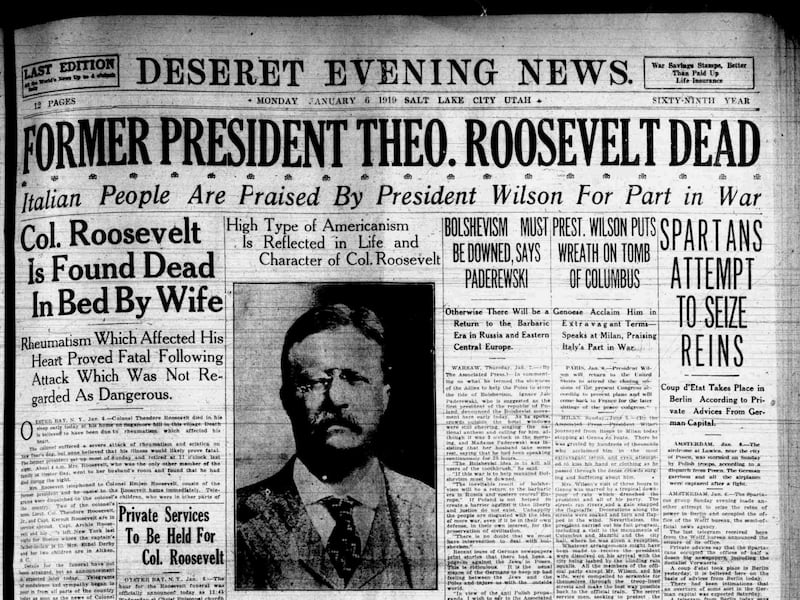Editor’s note: This story was originally published on Jan. 6, 2025.
A look back at local, national and world events through Deseret News archives.
On Jan. 6, 1919, former President Theodore Roosevelt died in his sleep in Oyster Bay, New York, at age 60.
That he was so young when he died might surprise many today.
Roosevelt, born in 1858 in New York, had been in declining health for several years, though he had hoped to return to politics to try for a third term in office (The 22nd Amendment now prohibits that). But the man had overcome much in his life. According to accounts, then U.S. Vice President Thomas Marshall, upon hearing the news that Roosevelt had simply gone to sleep and never awoke, said: “Death had to take him in his sleep, for if he was awake there’d have been a fight.”
A dynamic and energetic leader, Roosevelt is credited with creating the modern presidency. He served in state and national posts, and in 1898, as assistant secretary to the U.S. Navy, Roosevelt vehemently advocated war with Spain. When the Spanish-American War began, he formed the “Rough Riders,” a volunteer cavalry that became famous for its contribution to the United States victory at the Battle of San Juan Hill in Cuba.
In 1901, President William McKinley was assassinated, and Roosevelt, 43 years old, became the youngest president ever to assume the office.
On May 29, 1903, Roosevelt spoke at a gathering in Ogden — one of the main stops along the Transcontinental Railroad at the time — about the importance of the national irrigation system.
On Jan. 11, 1908, Roosevelt leveraged the Antiquities Act of 1906 to proclaim the Grand Canyon as a national monument; it would become a national park in 1919.
Roosevelt used his authority to protect wildlife and public lands by creating the U.S. Forest Service in 1905. Through the years, he established 150 new national forests, 18 national monuments, five national parks, and 51 wildlife refuges, protecting 172 million acres.
His image is captured at Mount Rushmore, along with fellow presidents George Washington, Abraham Lincoln and Thomas Jefferson.
Roosevelt is even credited with saving football in 1905.
A final anecdote: In 1902, Roosevelt, an avid hunter, had been invited to participate in a bear hunt in Mississippi. As the day wore on, the president had not located a single bear.
One of the presidents assistants cornered and tied a black bear to a willow tree, and suggested he shoot it. Viewing it as unsportsmanlike, Roosevelt refused.
The incident became national conversation, and a topic of political cartoons. A New York store owner decided to create a stuffed toy bear to sell, naming it “Teddy’s Bear.” The rest is history.
According to compilations in the Library of Congress, Roosevelt was a president of firsts:
- The youngest president.
- The first president to travel abroad during his time office.
- The first to ride in a submarine.
- The first conservationist president.
- The first president to make a public appearance by car.
- The first president to own a telephone.
- The first president to win a Nobel Peace Prize.
- He was also the first to ride in an airplane, though it was after he left office.

Here are some articles from Deseret News archives about Theodore Roosevelt, his accomplishments and his visit to Utah:
“Here’s the true story of how Teddy Roosevelt saved football”
“What U.S. presidents have said about Utah”
“President Theodore Roosevelt visited Utah in 1903 to defend a Latter-day Saint apostle”
“Deseret News archives: Roosevelt receives Nobel Prize in 1906, first American ever honored”
“Don’t miss profile of Teddy Roosevelt — it’s bully!”
“Century-old teddy bear still a hit”
“Teddy Roosevelt’s words about families ring true today”
“Teddy Roosevelt and his Congress were wrong”
“Teddy Roosevelt laid groundwork for preserving”



